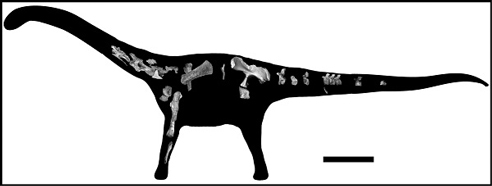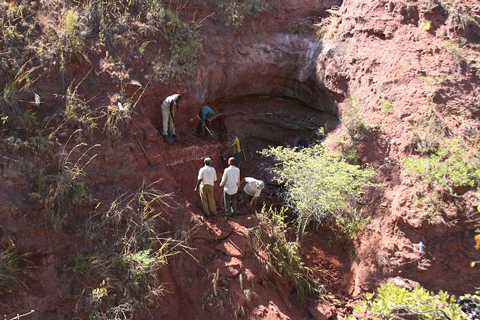New Species of Titanosaur Named – Rukwatitan bisepultus
Rukwatitan bisepultus – A Rare African Giant
Titanosaurs are a bit like buses, you wait for ages and then two of them come along together. No sooner did we complete our synopsis on the research on the colossal Dreadnoughtus schrani, a newly described titanosaur from south-western Patagonia, then we have the opportunity to discuss another new species, this time from Africa. This new titanosaur, named Rukwatitan bisepultus may not be quite as big as the newly described Dreadnoughtus but we at Everything Dinosaur estimate that fossils excavated from a hazardous cliff face in a steep quarry represent a dinosaur that was around ten metres long, or possibly much bigger.
Comparisons with the fossil bones from the Malawisaurus indicate that this titanosaur could have exceeded sixteen metres in length. This herbivore would have been able to survey its floodplain home from a height of approximately four metres.
Rukwatitan bisepultus
An Artist’s Impression of the New Titanosaur (Rukwatitan bisepultus)
Picture credit: Mark Witton
Studying Titanosaurs
But with titanosaurs, size isn’t everything. Rukwatitan may not be a record breaker in terms of its body mass but its discovery is perhaps more significant than the fossils of the South American giants. This is only the fourth genus of titanosaur discovered in Africa* and the palaeontologists at the University of Ohio, who excavated the fossils out of the cliff over two field seasons, are confident that their find will help scientists to understand more about the global distribution and the diversity of the titanosaurids as well as helping to piece together more data on the evolution of sub-Saharan dinosaurs.
A Silhouette of Rukwatitan bisepulutus Showing Fossils Found
Picture credit: Eric Gorscak (Ohio University)
The picture above shows a bauplan of the new titanosaur and the position of the fossil bones that were found in relation to the body plan.
Titanosaurs are wide-bodied sauropods that probably evolved sometime in the Late Jurassic and survived until the Cretaceous mass extinction event. They are the only sauropods known to have survived into the Late Cretaceous, but only in South America did these animals make up a significant proportion of the herbivorous megafauna, elsewhere, the ornithopods dominated. When compared to other types of Sauropoda, titanosaurs tended to have wider bodies, due to the more robust and larger pectoral area (chest). The limbs were strong and stocky, often the front limbs were longer than the hind limbs.
The spinal column was more flexible than in diplodocids, perhaps helping them to rear up more easily. The heads were small, proportionately smaller than other types of sauropod. Titanosaurs were geologically widespread and their fossils have been found on all the continents including Antarctica. A number of sub-families have been identified and some of the titanosaurids are amongst the largest, terrestrial vertebrates known to science.
To read about the Antarctica fossil find (2011): Titanosaurs of the Antarctic.
The fossils were found in the Rukwa Rift Basin area of south-western Tanzania (hence the genus name). Scientists from Ohio University in collaboration with several other universities have carried out a number of excavations from the Red Sandstone Group deposits, that form part of the Galula Formation. Fossils of turtles, crocodilians and primitive mammals have also been found in the formation, as well as dinosaur remains. The fossil bearing strata is believed to have been laid down approximately 100 million years ago (Late Albian faunal stage of the Cretaceous).
The Fossils were Excavated from a Steep Cliff Face
Picture credit: Patrick O’Connor (Ohio University)
The vertebrates associated with the Galula Formation have shown some unique anatomical features indicating that the floodplain environment which is represented by these sandstone deposits may have been separated from other parts of Gondwana, permitting a unique fauna to evolve. Last year, scientists from Ohio University reported the discovery of a new type of crocodilian (Rukwasuchus yajabalijekundu) that was different from other crocodilians found in deposits of the same geological age but from further north.
Some of the Fossils Exposed after Excavation
Picture credit: Ohio University
One of the authors of the scientific paper, published in the “Journal of Vertebrate Palaeontology”, Patrick O’Connor (Professor of Anatomy at Ohio University) stated:
“There may have been certain environmental features, such as deserts, large waterways and/or mountain ranges that would have limited the movement of animals and promoted the evolution of regionally distinct faunas. Only additional data on the faunas and the palaeo-environments from around the continent will let us further test such hypotheses.”
Two Caudal Vertebrae (Tail bones) from the Site
Picture credit: Ohio University
* Team members have had a go at naming the four genera of African titanosaurs currently described, here we go:
- The basal titanosaur from Tanzania (Upper Tendaguru Formation) – Janenschia robusta (Late Jurassic)
- The Lithostrotian titanosaur from Malawi (unknown formation) Malawisaurus dixeyi (Cretaceous)
- The basal Lithostorian titanosaur? Rukwatitan bisepulutus (described above)
- The Lithostrotian titanosaur from Egypt (Bahariya Formation) Paralititan stromeri (Late Cretaceous)
To read the acclaimed article written by Everything Dinosaur on the newly discovered titanosaur Dreadnoughtus: New Titanosaur from South-Western Patagonia.






